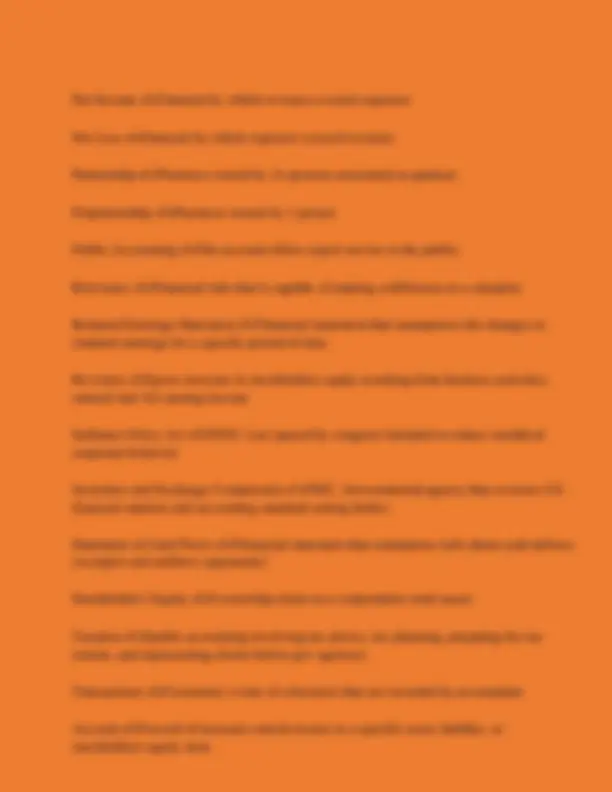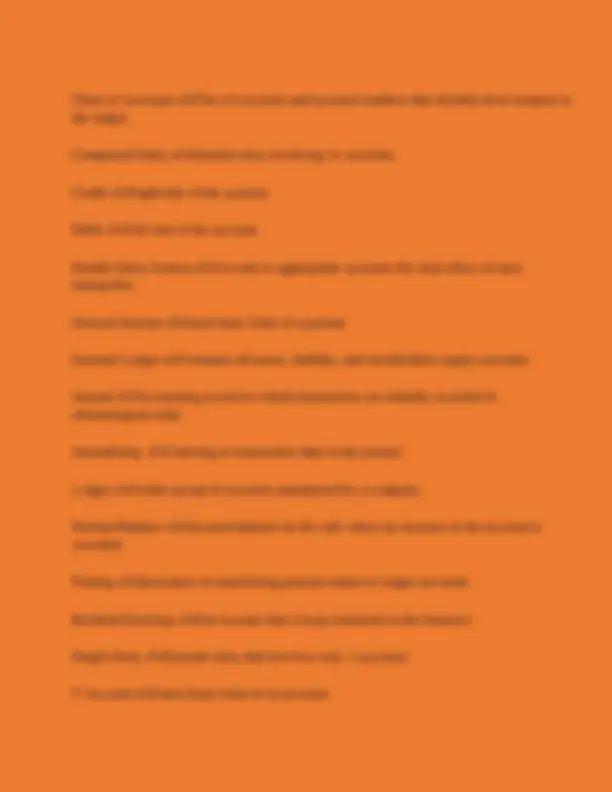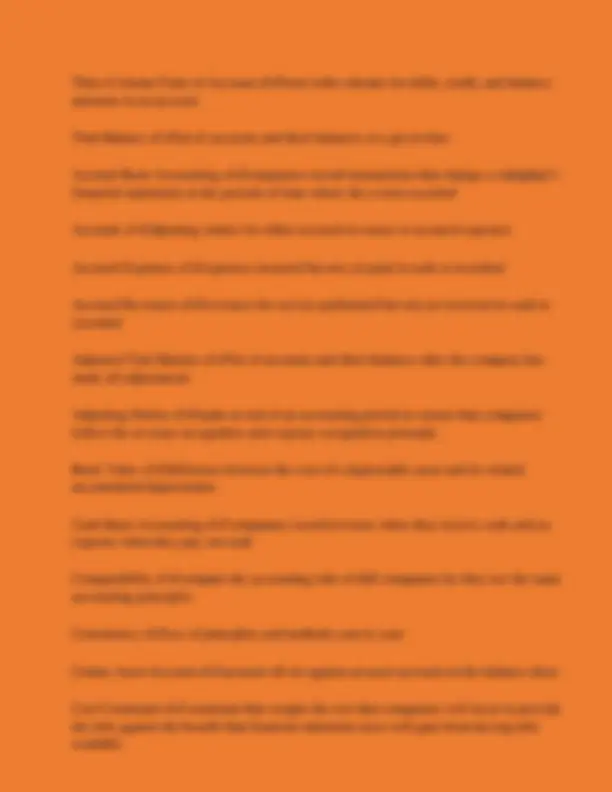





Study with the several resources on Docsity

Earn points by helping other students or get them with a premium plan


Prepare for your exams
Study with the several resources on Docsity

Earn points to download
Earn points by helping other students or get them with a premium plan
Community
Ask the community for help and clear up your study doubts
Discover the best universities in your country according to Docsity users
Free resources
Download our free guides on studying techniques, anxiety management strategies, and thesis advice from Docsity tutors
A comprehensive list of key accounting terms and definitions, covering chapters 1-4 of an introductory accounting course. It includes explanations of fundamental concepts such as assets, liabilities, stockholders' equity, financial statements, and accounting principles. Useful for students preparing for an exam or reviewing core accounting concepts.
Typology: Exercises
1 / 7

This page cannot be seen from the preview
Don't miss anything!




Accounting ✔✔info system that identifies, records, and communicates the economic events of an organization to interested users Assets ✔✔resource a business owns Auditing ✔✔examination of financial statements by a certified public accountant in order to express an opinion as to how accurately the financial statements present the company results and financial position Balance Sheet ✔✔financial statement that reports the assets, liabilities, and stock holders’ equity at a specific date. Basic Accounting Equation ✔✔Assets = Liabilites+Stockholder's Equity Bookkeeping ✔✔part of accounting that involves only the economic recording of events Common Stock ✔✔describes the total amount paid in by stockholders for the shares they purchase Convergence ✔✔process of reducing the differences between US GAAP and IFRS Corporation ✔✔business organized by a separate legal entity under state corporation law, having ownership divided into transferable shares of stock Dividend ✔✔a distribution by a corporation to its stockholders Economic Entity Assumption ✔✔an assumption that requires that the activities of the entity be kept separate and distinct from the activities of its owner and all other economic entities Ethics ✔✔standards of conduct by which ones actions are judged as right or wrong, honest or dishonest, fair or unfair Expanded Accounting Equation ✔✔Assets=Liabilities+Common Stock+Revenues- Expenses-Dividends
Expenses ✔✔cost of assets consumed or services used in the process of earning revenue Fair Value Principle ✔✔states that assets and liabilities should be reported at fair value Faithful Representation ✔✔numbers and descriptions match what really existed or happened - factual Financial Accounting ✔✔provides economic and financial info for investors, creditors, and other external users Financial Accounting Standards Board (FASB) ✔✔private organization that establishes generally accepted accounting principles in the US Forensic Accounting ✔✔uses accounting, auditing, and investigative skills to conduct investigations into theft and freud GAAP ✔✔generally accepted accounting principles. Common standards that indicate how to report economic events Historical Cost Principle ✔✔states that companies should record assets at their cost Income Statement ✔✔financial statement that presents the revenues and expenses resulting net income or net loss of a company for a specific period of time International Accounting Standards Board ✔✔IASB. Standard setting body that issues standards adopted by many companies outside the US International Financial Reporting Standards ✔✔IFRS. Internation accounting standards set by the IASB Liabilites ✔✔creditor claims against total asset Management consulting ✔✔area of public accounting ranging from development of accounting and computer systems to support services for marketing projects Monetary Unit Assumption ✔✔assumption stating that companies include in the accounting records only transactions data that can be expressed in terms of money
Chart of Accounts ✔✔list of accounts and account numbers that identify their location in the ledger Compound Entry ✔✔journal entry involving 3+ accounts Credit ✔✔right side of the account Debit ✔✔left side of the account Double Entry System ✔✔records in appropriate accounts the dual effect of each transaction General Journal ✔✔most basic form of a journal General Ledger ✔✔contains all assets, liability, and stockholders equity accounts Journal ✔✔accounting record in which transactions are initially recorded in chronological order Journalizing ✔✔entering of transaction data in the journal Ledger ✔✔entire group of accounts maintained by a company Normal Balance ✔✔account balance on the side where an increase in the account is recorded Posting ✔✔procedure of transferring journal entries to ledger accounts Retained Earnings ✔✔net income that is kept (retained) in the business Single Entry ✔✔journal entry that involves only 1 accounts T-Account ✔✔most basic form of an account
Three-Column Form of Account ✔✔form with columns for debit, credit, and balance amounts in an account Trial Balance ✔✔list of accounts and their balances at a given time Accrual-Basis Accounting ✔✔companies record transactions that change a company’s financial statements in the periods of time where the events occurred Accruals ✔✔adjusting entries for either accrued revenues or accrued expenses Accrued Expenses ✔✔expenses incurred but not yet paid in cash or recorded Accrued Revenues ✔✔revenues for service performed but not yet received in cash or recorded Adjusted Trial Balance ✔✔list of accounts and their balances after the company has made all adjustments Adjusting Entries ✔✔made at end of an accounting period to ensure that companies follow the revenue recognition and expense recognition principle Book Value ✔✔difference between the cost of a depreciable asset and its related accumulated depreciation Cash Basis Accounting ✔✔companies record revenue when they receive cash and an expense when they pay out cash Comparability ✔✔compare the accounting info of diff companies by they use the same accounting principles Consistency ✔✔use of principles and methods year to year Contra Asset Account ✔✔account off set against an asset account on the balance sheet Cost Constraint ✔✔constraint that weighs the cost that companies will incur to provide the info against the benefit that financial statement users will gain from having info available
Unearned Revenues ✔✔liability recorded for cash received before services are performed Useful Life ✔✔length of service of a long-lived asset Verifiable ✔✔Quality of info that occurs when independent observers, using the same methods, obtain similar results